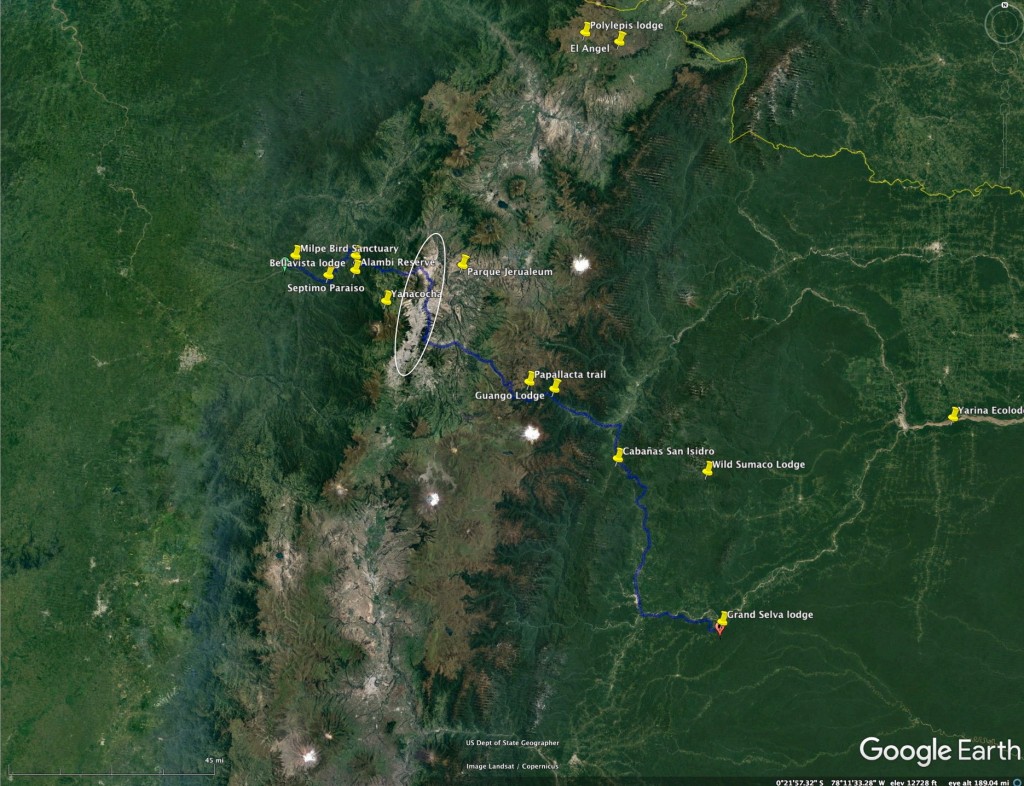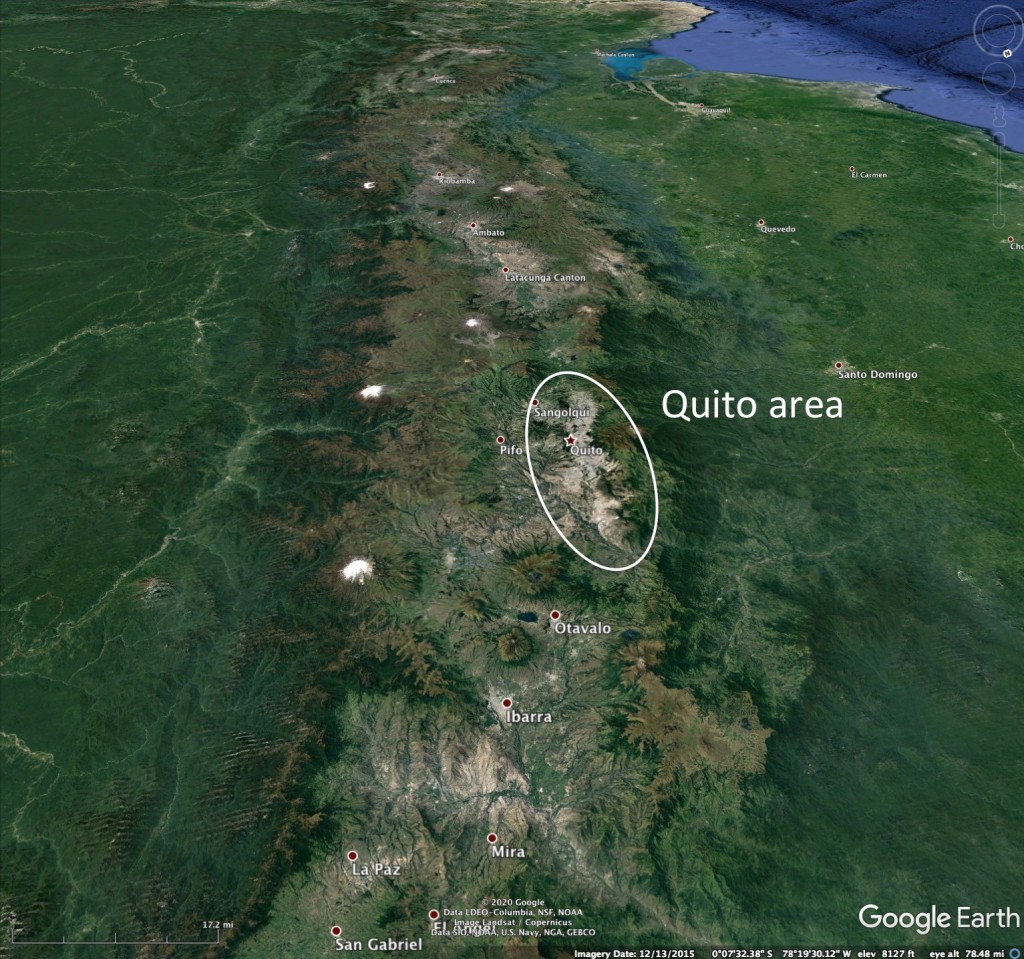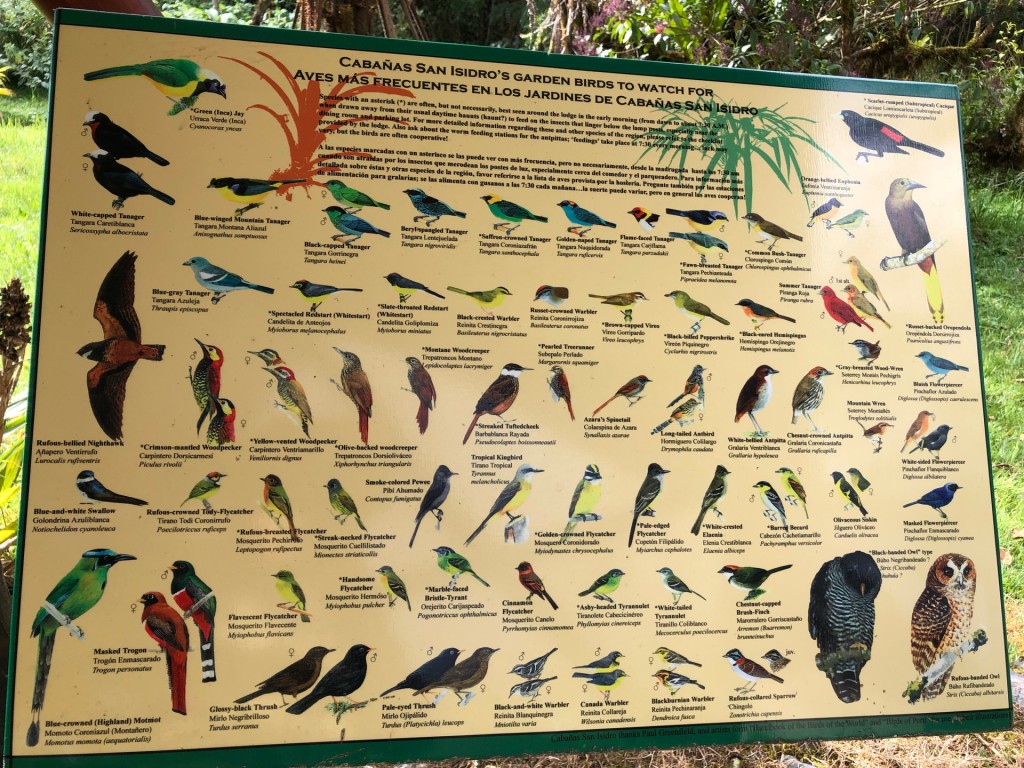In July and August 2019 we traveled to Peru and Ecuador for about 30 days. The main objective of the travel was to attend an International Biogeography Society Meeting celebrating the 250th anniversary of the birth of Alexander von Humboldt. This meeting was held at the Universidad San Francisco de Quito and details of the meeting can be seen here. This page describes some basic aspects of travel in Ecuador and we also provide some travel advice for naturalists wanting to see the natural aspects of Ecuador. Our recent trip is described here. Our perspectives are from naturalists traveling to see nature. Different opinions would naturally come from others who might be focusing on the cultural aspects of Ecuador.
Since we are “formally retired” we also built travel of personal interest into this conference-related trip. One trip, prior to the conference, was primarily to the Marañon River region in northern Peru and is summarized here. Our second travel segment was after the Quito Conference, and involved sampling birding destinations on both the western and eastern Andean slopes of Ecuador. This travel, as well as background material on Ecuadorean natural history, is described in the material below.
Overview of Ecuador and its “nature”
We are not experts on the nature and natural history of Ecuador, but we have traveled there on work several decades ago and have rented vehicles and driven across parts of the country both in the distant past and very recently (2019). A summary of Ecuador’s climatology was prepared for the 2019 Conference participants as well as a talk. Here we will summarize quickly the essential climatic and geographical aspects of Ecuador.
The basic physical relief of Ecuador is shown in Fig. 1. Broadly speaking, the Andes separate the Amazonian lowlands in the East from the Pacific lowlands of Ecuador in the west. And although Ecuador is close to the Equator, the climate does vary and is different on either side of the Andes. A strong dry season is seen in southwestern Ecuador while there is rain every month in eastern Ecuador (Fig. 2). The eastern Andean slopes are routinely cloudy, with winds generally from the east, while the western slopes of the Andes can be cloud-free on many mornings, with late afternoon showers (more frequent towards Colombia).

The Andes are not simply a single mountain range; they have two main north-south ranges punctuated by high volcanoes. Between the eastern and western ranges is the so-called inter-Andean valleys (Quito and most population centers lie in them). These valleys are quite dry compared with the eastern and western Andean slopes, and have some unique xeric vegetation. The inter-Andean valleys are conspicuous on satellite-derived cloud climatologies (Fig. 3 and 4).




Fig. 3. Click on the images for detailed captions.



Fig 4. View of Ecuadorean Andes looking southward. Toggle between the images to see the relation between the topography and cloudiness and the forest cover. High mountains with ice appear as maxima in the mean cloudiness depiction (the grayscale image where cloudiness is proportional to the brightness).
Getting around Ecuador: some details important for the nature traveler
The natural history attractions in Ecuador are varied, and can include rainforest “exploration”, birding at many lodges, or hiking glacier-capped volcanoes. And of course there are the Galapagos Islands, discussed elsewhere.
Although Ecuador is a relatively small country compared with its neighbors, the extreme topography and resultant windy roads make driving tedious and longer than many tourists might be accustomed to for similar distances elsewhere. Landslides can block roads, and slow trucks combined with very curvy roads make for slow – and sometimes dangerous driving. Then the roads themselves are a problem for the nature explorer. Although the pavement on newer roads can be excellent, the sides of the roads usually have deep culverts to channel water and collect rocks from rockslides, and these culverts make it very difficult to pull your vehicle off the road. Thus the driver must stop on the road – a very undesirable action on mountainous roads where fast downhill drivers can suddenly appear. There are very few passing/overtaking lanes in Ecuador, so passing slow trucks can be dangerous on mountain roads. Figure 5 shows some of the road conditions we found on our recent trip. Many road stretches are relatively worry-free but we chose these examples to illustrate what you will likely encounter at least occasionally.
Fig. 5. Examples of road conditions encountered during our recent trip to Ecuador. In fairness to Ecuador, these conditions might be encountered in most Andean countries. Click on any image to see text explaining the image.
Natural history travelers should not expect roads to be entirely free of traffic. Roads in Latin America – and in most of the world – are built to connect people or industries. Do not expect a good road to be free of traffic, but sometimes roads can be lightly traveled if they do not connect major population centers.
The option of taking taxis in Ecuador should be considered. Taxi fares can be comparable with rental car rates so it is not necessarily a good idea to rent a vehicle – especially if your ability to stop wherever you want is limited by the road conditions. And for many individuals – who will stay multiple days at birding or Amazon lodges, a rental car will not be that useful while you are at the lodges. Many lodges can arrange to have you transported from one location to another via taxis they contract with. This provides security and convenience. This is most economical if you are staying multiple days at each lodge you visit, since a rental vehicle will not really be necessary when you are at the lodge as going out to eat really isn’t a convenient option given most lodges isolation. However, if you are visiting different lodges every day then a rental vehicle may be the most practical option.
A few caveats regarding taxis. Many drivers, if not most, assume you want to get to your destination as rapidly as possible. This is 1) how they make more money and 2) how you save time. But nature travelers may want to go slower to 1) see more along the way and 2) avoid getting car sick on windy roads. Make sure your driver understands that you might want to stop along the way and that he (rarely “she”) should not drive as quickly as possible. You don’t want to spend the rest of your day recovering from your ride! An advantage of self-drive is that it is easier to control the speed at which you drive, especially on curvy roads. Unfortunately, if there is traffic behind you it is not always possible to go as slowly as you might like.
More recommendations for Ecuador can be found here. Basic travel planning tips can be found here.
Birding lodges and “Shamu” experiences
During our 2019 trip we stayed at four lodges including three (Guango, Cabañas San Isidro and Septimo Paraiso) that catering primarily to birders. Most birding lodges are sufficiently remote from nearby towns that the practical solution for food is to purchase the meals at the lodge (these are often part of the overall price). Lodges catering to birders will have hummingbird feeders, fruit trays to attract tanagers and jays and even lights at night to attract moths and beetles for insectivorous birds to feast on the following morning. The need to maintain feeders, walking trails and restaurants with few customers (compared with those in towns), along with the remote nature of the lodges (usually surrounded by forest) means that the daily costs are substantially higher than hotels found in towns. Most birding lodges and their trails can be visited on day trips for a modest fee, so this can be an option for those staying in nearby towns and wising to see the birds. Transportation to and from the nearby town to the lodge will then become the issue. Likewise, nighttime activities (looking for owls, watching the moths coming to lights, frog hunting etc) will be unavailable to day visitors, as well as dawn activities (early morning visits are much harder logistically to non-guests and often restricted in any case to after a certain hour).
Some towns, like the touristic town of Mindo on the western slope of the Andes, can be a convenient base for birding activities as it is only a few miles to some birding locations and it has a wide selection of places to eat. However, many other birding areas – such as those east of the Andes (e.g. Guango, Cabañas San Isidro, and all of the lowland Amazonian lodges) are quite far from touristic towns and visits to these birding locations are best done with lodging and food included.
















Fig. 6. While it is easy to criticize birding lodges for their “unnatural” feeding environments by which they attract birds, it does make these birds very convenient for photography. The challenge for the photographer is getting photos that look “natural” – no feeders in the photos and no artificial backgrounds. Here is a sampling of hummingbird images obtained from different lodges. All photos are crops of the original images; some are with flash and others are using natural light.
Comments for bird photographers
Birding lodges, with their specialized feeding strategies to attract birds, can be see as akin to visiting a zoo in a natural setting. One birder we spoke with termed this a “Shamu” experience (for non-Americans, Shamu was a trained Killer Whale that performed on call in shows at Sea World, an ocean-themed amusement park in the US). Attracting birds to feeders is akin to training them to come to you on demand.
Some lodges have a morning Antpitta feeding. A guide will place earthworms on a log, then call the birds early in the morning. The Antpittas have learned to come for a morning snack. Some non-lodge locations also offer this activity. One well-know location is the Refugio Paz de las Aves. Such ground dwelling forest birds can be very hard to see otherwise.
Unfortunately, many birds are hard to see without feeders and photography is vastly easier when birds reliably visit feeders. Despite this, many birds do not visit feeders and walking a lodge’s trails is necessary to see such birds.
For bird photographers, the challenge to photographers is to obtain ‘natural” photos – ones that don’t show the feeder. Most feeding stations have shrubs or branches near them where most species will perch – if only very fleetingly. Some of the branches in Fig 1 were placed by the lodge near the feeder to encourage the birds to perch – for easier viewing and photos. The resultant photos give the impression that the bird was in a natural setting. This allows the photographer say “I got the shot after a long hike in rough terrain”. Sounds better than “I sat by the feeder and waited till the bird came and I then took the photo”. The same strategy works for Zoo photos – get close enough to your lion and if the background is really out-of-focus you can then say you got the shot in the wilds of Africa.
We found that natural light worked better for showing the colors of birds such as hummingbirds, though the compromise was that higher ISO values were needed and there was less depth-of-field. Using flash ensures a better chance of sharper images, but the reflections are much more unpredictable. (We are not primarily bird photographers – which is a specialty in itself – that requires lots of patience, good techniques, and appropriate equipment.)
Uniqueness of Birding Lodges and Amazonian lodges
“Amazonian lodges” are not exactly the same as “Birding lodges”. To get to most Amazon lodges you may have to fly to a town (e.g. Coca) in the eastern lowlands, then take a three-hr motorized canoe trip downriver to your lodge. Yes, you will see birds, but you might also see River Dolphins, Giant Otters and a host of fish and mammals that birding lodges won’t be able to show you. But the daily cost per person is considerably higher at such lodges, and you are not free to wander trails without a guide (unlike at birding lodges).
Most birding lodges are set at mid-elevations, roughly in “cloud forest” environments. Because many birds favor certain elevational ranges, lodges at different elevations may provide different birds at the feeders and in the surrounding forests. For example, on the western slope near the town of Mindo there are lodges (or specialized bird viewing facilities) at 2800m (Bellavista), 1700m (Tandayapa), 1600m (Septimo Paraiso) and at 1150m (Milpe). On the eastern slope we find birding lodges at 2700m (Guango), 2050m (Cabañas San Isidro) and 1460m (Wild Sumaco). Amazonian lodges (there are many) are much lower – between 200 and 400m elevation.
Each birding lodge tries to attract clients by advertising something that make them unique compared with their neighboring competitors. At Cabañas San Isidro it is the possibility of seeing a “new” owl species. At Bellavista Cloud Forest Lodge it is the Olinguito, a rare racoon relative. At others it might be convenient access to a Cock-of-the-Rock Lek. Yet others offer the chance of seeing Antpittas difficult to see elsewhere.
What is good and “less-good” about the Ecuadorean nature lodges
In our limited experience the birding lodges excel in providing viewing opportunities for hummingbirds and many other birds that come to feeders. Most have good trails, though the cloud forest trails tend to be muddy and some are quite steep. Fortunately, all lodges provided rubber boots for use on the trails – a big plus in having to not bring such boots!
Most lodges have plaques describing the main birds to be seen and these are placed near the feeders. There are also field guides usually available, but the quality of the viewing platforms varies among the lodges; Cabañas San Isidro has the best viewing deck we visited but others are adequate for bird photography.




Despite the presence of trails, most lacked information to educate those walking them. Only one lodge had a trail with plaques – and these were coated with lichens and mosses due to the perpetually high humidity.
What we’d like to see improved
More information needed… and volunteered. Some lodges did not provide enough information at the outset (like a normal hotel that has a book in each room that contains all of the information a guest might like to know). For example, a summary of the trails, eating times, bird lists, what is for dinner etc. Little to no information was available on the uniqueness of the lodge environment, the uniqueness of the habitat, and virtually nothing about the plants. No mention of the palms, epiphytes, differences between the cloud forest and lowland forests etc. Perhaps most visitors come with guides that provide this information (we doubt this) or the focus of most visitors is strictly on birds and little else (unfortunately this may be closer to the truth). In our experience a great many people would appreciate knowing more about the different epiphytes, the altitudinal zonation of the birds or palms, or what distinguishes a cloud forest from the Amazonian lowland forest. Or the cloud forests on the western slopes – how are they different from the eastern slope cloud forests? So much knowledge could be conveyed to the visitors! Our discussions with various guides suggested that this level of knowledge simply isn’t taught to the guides, or that those who have this level of knowledge aren’t motivated to convey it to visitors. Perhaps it is partly the visitor’s fault for not asking about anything other than birds!
Recommendation for Ecuador and other neotropical countries
Our experience in Ecuador convinced us that the nature lodge and guiding community needs to consider developing nature guiding schools in a similar vein to those that exist in South Africa. Such programs have formal training of approximately 6 months, with internships lasting another 6 months. A wide variety of subjects are covered, some not relevant to the neotropics but most material of high value. Different guiding categories could be developed so that tourists would be able to select guides based not only on their subjective personal reviews (but by their training in specific areas).
Of course, we have recommendations for tourists traveling to see nature in Ecuador. You have to do your homework – and background reading – to get the most out of your experience. Prepare yourself by reading basic tropical natural history books such as Tropical Nature or A Neotropical Companion. There are many others, of varying complexity. Books specific to the natural history of Ecuador are far fewer, and most of these tend to be lavishly illustrated photo books or guides lacking in tropical ecology concepts and plant information.
For those wanting to see what the cloud cover looks like over Ecuador now we’ve put two links here for convenience:
Link to IR animation for the Ecuador region
Link to Visible imagery animation for the Ecuador region
Much more information about Ecuador’s climate can be found here.














